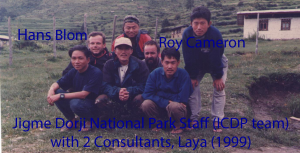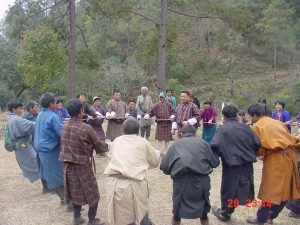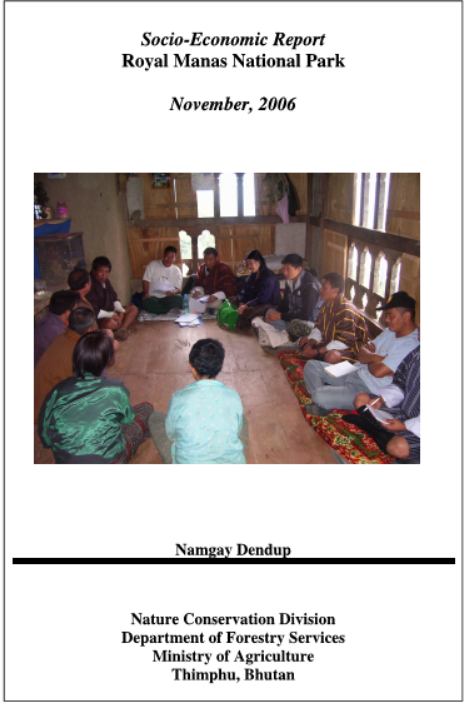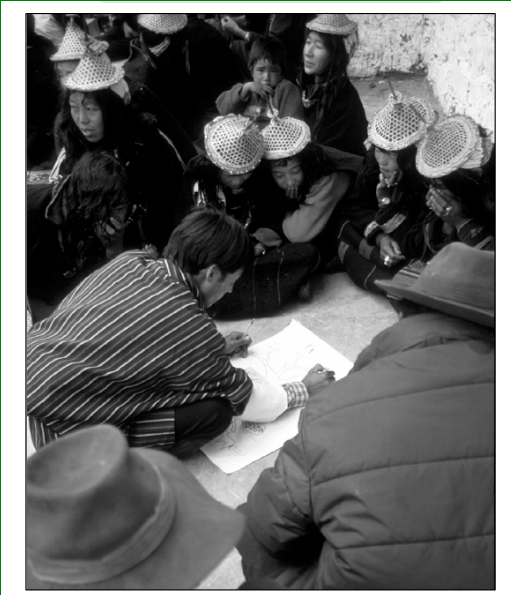“Impossible is found in fool’s dictionary” as per the old maxim has been true for me as I embarked on working in a completely different field (socio-economist) than my professional field of studies (forestry and wildlife).  So I am glad to share the challenges and opportunities during my tenure with the forestry department of Bhutan’s government while making a modest contribution in undertaking socio-economic surveys and formulating Integrated Conservation and Development Projects in the protected areas of Bhutan, and ecotourism activities from 1997 till 2017.
So I am glad to share the challenges and opportunities during my tenure with the forestry department of Bhutan’s government while making a modest contribution in undertaking socio-economic surveys and formulating Integrated Conservation and Development Projects in the protected areas of Bhutan, and ecotourism activities from 1997 till 2017.
While I was excited to get Jigme Dorji National Park, the largest park during that time, it was a nightmare to have been assigned to look after Integrated Conservation and Development Programs (ICDP). The park has to be traversed on foot during that time. In fact, I was designated as ICDP Warden for Jigme Dorji National Park. ICDP has been totally new subject to me as we were never taught during our traditional forestry course in India. And it was also new to Bhutan. The matter became worst as ICDP was to be piloted in Jigme Dorji National Park through UNDP-GEF funding. The responsibility was huge as I have to learn the concept from the scratch. Fortunately, my brother had attended 3 months of training on Extension in the UK and shared his notes on some participatory rural appraisal toolsets. I also readied by going over the UNDP-GEF project documents, park management plan, and whatever little documents on ICDP hard copies in other countries.
 Why ICDP in protected areas? Unlike other countries, Bhutan’s protected areas (national parks, wildlife sanctuaries, etc) are unique as we have many local communities living in tandem with the forest ecosystem. The systems in other countries are that the local communities are not entitled to stay inside the protected areas, and as such they get re-settled elsewhere. Jigme Dorji National Park where I was posted was not just inhabited by local communities, even the whole Gasa district was situated inside the park along with some portion of Thimphu, Paro, and Punakha district. So the functionary of ICDP was crucial as its main objective was to integrate the development needs of local communities without undermining the conservation goal of the national park.
Why ICDP in protected areas? Unlike other countries, Bhutan’s protected areas (national parks, wildlife sanctuaries, etc) are unique as we have many local communities living in tandem with the forest ecosystem. The systems in other countries are that the local communities are not entitled to stay inside the protected areas, and as such they get re-settled elsewhere. Jigme Dorji National Park where I was posted was not just inhabited by local communities, even the whole Gasa district was situated inside the park along with some portion of Thimphu, Paro, and Punakha district. So the functionary of ICDP was crucial as its main objective was to integrate the development needs of local communities without undermining the conservation goal of the national park.
It took me more than 1 year to get acquainted with the concept of ICDP, thanks to my passion in learning, the various in-country workshop and training abroad (3 weeks Participatory Approaches to Protected Area Management at RECOFTC, Bangkok, Thailand). The piloting of ICDP was timely as it was working in line with the Decentralization policy of the government (where the Ministry of Home and Affairs was also spearheading the participatory approaches of development). Further, I was being joined by 2 UNV consultants (Natural Resource Manager and Social Forester) in 1998 and they stayed for 3 years. It was grabbing the right moment at the right time as I was directly assigned as a National counterpart to them. In fact, with one consultant we used Laya (Gasa district) as our pilot site to launch ICDP programs, where we were stationed during 1999 – 2000 for six months. During that time we have to traverse on foot for 4 days from Tashithang (the nearest motorable road to reach Laya) and the communication facilities were minimal as we have to rely upon the wireless network to keep in touch with the outside world.
 Briefly Integrated Conservation and Development Programs (ICDP) encompass the following processes. Various participatory approach tools such as Rapid Rural Appraisal (RRA) Participatory Rural Appraisal (PRA), and Participatory Learning and Action (PLA) along with Socio-economic Surveys (through Semi-structured Interview and formal Interviews) are employed. Almost all the activities are carried out by a multi-sectoral team comprising staff from forestry, agriculture, veterinary, health, schools, etc. The planning has to be participatory involving local communities and the outcomes of plans/programs are presented to district headquarters (chaired by Dzongdag – the district administrator). Then it has to be presented to the department and to Ministry’s Secretariats (as it involves cross-sectoral namely; agriculture, veterinary, National Mushroom centers, Research centers, and even other departments such as the Institute of Medicinal services, Tourism, trade, etc). Finally, the plans/programs get endorsed and are being implemented on the ground and then monitored and, evaluated. Later such plans/programs were being replicated throughout Jigme Dorji National Park and other parks.
Briefly Integrated Conservation and Development Programs (ICDP) encompass the following processes. Various participatory approach tools such as Rapid Rural Appraisal (RRA) Participatory Rural Appraisal (PRA), and Participatory Learning and Action (PLA) along with Socio-economic Surveys (through Semi-structured Interview and formal Interviews) are employed. Almost all the activities are carried out by a multi-sectoral team comprising staff from forestry, agriculture, veterinary, health, schools, etc. The planning has to be participatory involving local communities and the outcomes of plans/programs are presented to district headquarters (chaired by Dzongdag – the district administrator). Then it has to be presented to the department and to Ministry’s Secretariats (as it involves cross-sectoral namely; agriculture, veterinary, National Mushroom centers, Research centers, and even other departments such as the Institute of Medicinal services, Tourism, trade, etc). Finally, the plans/programs get endorsed and are being implemented on the ground and then monitored and, evaluated. Later such plans/programs were being replicated throughout Jigme Dorji National Park and other parks.
It was a huge learning process for me to learn completely different concepts other than just forestry and wildlife. Further, I feel very much indebted to Roy Cameron (UNV consultant) with whom I was attached for 3 years. He was a real champion in getting participatory approaches to be realized in the field. In fact he has been crucial in conducting similar training/workshops across the globe before coming to Bhutan. He also benefitted a lot of staff from other sectors apart from me.
Having had the above experiences of piloting ICDP in Jigme Dorji National Park, I was transferred to Nature Conservation Division (NCD) beginning in 2002. During that time NCD was the nodal agency responsible for managing all protected areas of Bhutan. And supposedly the individual with subject expertise was retained to provide technical backstopping to protected areas. My responsibility was to coordinate ICDP activities in the protected areas of Bhutan. Here I am not claiming to be a subject specialist on ICDP but one who has had enough experience in the field. In the meantime, I received SAARC Scholarship Award to pursue Post Graduate Diploma in Wildlife Management and Eco-development at the Wildlife Institute of India, Deharadun during 2002- 2003 (the premier wildlife institute of South Asia). I begged Honours as well as a Gold Medal for the Top Foreign Candidate (India, Bhutan, Sri Lanka, Nepal, Maldives, Laos, and Cambodia). It further boosted my profession.
 My transfer to NCD coincided with the updating and/or preparation of a new management plan for most of the national parks and wildlife sanctuaries in Bhutan. During the management plan preparation of different National Parks in Bhutan, we have to undertake various surveys namely; birds, plants, mammals, and socio-economic to provide input for management plan preparation. In order to judiciously utilize the resources, we used to form teams consisting of the above experts and provide in-house theory and practical sessions to park staff prior to commencing various surveys. While I was involved as a lead person in the conduct of socio-economic survey training, I have been quite fortunate to have received several in-house training on plants, mammals, and birds during such holistic training programs from my other co-trainers. By default I was assigned to lead socio-economic surveys as there was no subject specialist, although I was well acquainted with the biodiversity surveys (plants, mammals, and birds) as I was professionally trained in these subjects.)
My transfer to NCD coincided with the updating and/or preparation of a new management plan for most of the national parks and wildlife sanctuaries in Bhutan. During the management plan preparation of different National Parks in Bhutan, we have to undertake various surveys namely; birds, plants, mammals, and socio-economic to provide input for management plan preparation. In order to judiciously utilize the resources, we used to form teams consisting of the above experts and provide in-house theory and practical sessions to park staff prior to commencing various surveys. While I was involved as a lead person in the conduct of socio-economic survey training, I have been quite fortunate to have received several in-house training on plants, mammals, and birds during such holistic training programs from my other co-trainers. By default I was assigned to lead socio-economic surveys as there was no subject specialist, although I was well acquainted with the biodiversity surveys (plants, mammals, and birds) as I was professionally trained in these subjects.)
My position as ICDP co-ordinator was challenging as everything has to be managed by myself as there was no consultancy support. I have to design survey methodologies, prepare survey questionnaires, impart training to staff, conduct socio-economic surveys, prepare databases, and undertake analysis to report production. Importantly I have to prepare ICDP plans for various protected areas including various ecotourism plans vis-a’-vis Community based tourism.
It was in 2009 that due to the organizational development exercises carried out by Royal Civil Service Commission for the whole Bhutanese civil service, Nature Conservation Division was bifurcated into Wildlife Conservation Division (WCD) and Nature Recreation Ecotourism Division (NRED). WCD was to focus only on wildlife and NRED was to focus on social aspects. As such, I was transferred to NRED in 2010 to look after social aspects mainly ecotourism activities in Bhutan.
The above opportunity enabled me to travel the length and breadth of the country on several occasions and to have intimate interaction with local communities and other people. While recollecting back there is not a single major local community that I have not visited, starting from the earliest Bhutanese settlers (the Monpas of Jangbi and Rukha) to the pastoral community (the brokpas and bjops – highland community of Merak Sakteng and Laya, Lunana, Ligshi), agricultural community (the Ngalongs, lhotshampas, sharchopas, and khengpas). All these enabled me to have in-depth and first-hand knowledge of local livelihood, traditions, culture, history, floral and faunal knowledge of the various regions of Bhutan, some of which are being documented in the following reports.
 Publications and Reports (latest first)
Publications and Reports (latest first)
- Dendup, N. 2012 Community Based Ecotourism for Aja Ney, Bumdilling Wildlife Sanctuary (World Bank Project), Nature Recreation and Ecotourism Division, Department of Forests and Parks Services, Ministry of Agriculture, Thimphu, Bhutan.
- Dendup, N. 2012. Socioeconomic Survey Report of Jigme SingyeWangchuck National Park,Nature Conservation Division, Ministry of Agriculture, Bhutan.
- Dendup, N. and B. B. Ghalley 2011. Socioeconomic Survey Report, Toorsa Strict Nature Reserve, Nature Recreation and Ecotourism Division, Department of Forests and Parks Services, Ministry of Agriculture, Bhutan.
- Dendup, N. 2011. Socioeconomic Survey Report of Wangchuck Centennial Park (Part 2), Nature Conservation Division, Ministry of Agriculture, Bhutan.
- Dendup, N. and Wangchuk, K. 2010. Systematization and Analysis of the Contribution of National Parks and Biological Reserves to the Economic and Social Development in Costa Rica, Benin and Bhutan. A Case Study from Jigme Singye Wangchuck National Park, Nature Conservation Division, Ministry Agriculture,Thimphu.
- Dendup, N. 2010. Socioeconomic Survey Report of Phibsoo Wildlife Sanctuary, Nature Conservation Division, Ministry of Agriculture, Bhutan.
- Dendup, N. 2009. Socioeconomic Survey Report of Royal Botanical Recreational Park, Nature Conservation Division, Ministry of Agriculture, Bhutan.
- Dendup, N. 2008. Socioeconomic Survey Report of Wangchuck Centennial National Park Part 1), Nature Conservation Division, Ministry of Agriculture, Bhutan.
- Dendup, N. 2008. Evaluation Report of Integrated Conservation and Development Program for Thrumshingla National Park, Nature Conservation Division, Ministry of Agriculture, Bhutan.
- Dendup, N. 2006. Socioeconomic survey report of Royal Manas National Park, Nature Conservation Division, Ministry of Agriculture, Bhutan.
- Dendup, N. 2004. Socioeconomic assessment in Sakteng Wild life Sanctuary, Nature Conservation Division, Ministry of Agriculture, Bhutan.
- Dendup, N. 2004. Participatory Learning and Action: A Manual for Conducting PLA Fieldwork in Protected Areas. Nature Conservation Division, Ministry of Agriculture, Thimphu.
- Dendup, N. and R. Cameron 2000. Integrated Conservation and Development Plan: a pilot project in Laya Geog, Gasa dzongkhag. Jigme Dorji National Park, Nature Conservation Division, Ministry of Agriculture, Bhutan.

